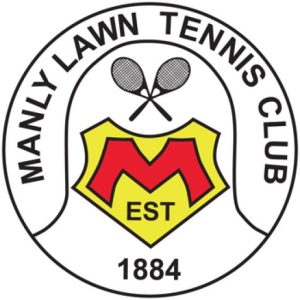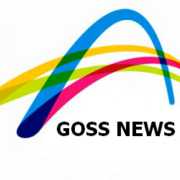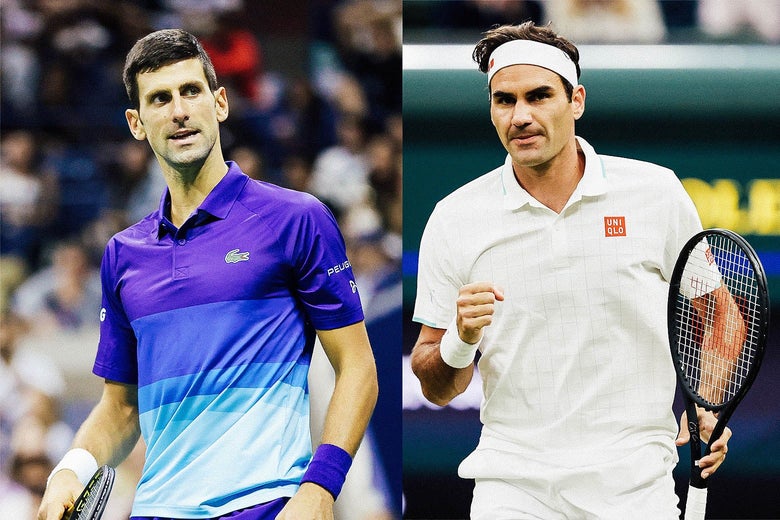Until Sunday, no one in the past half-century had come remotely close to completing tennis’s Grand Slam in men’s singles: To win even the first three of the four major tournaments in a calendar year had proved too difficult for all the male champions of those five decades. But this past weekend, Novak Djokovic came within not only one tournament but one match of the Slam—an achievement in its own right that, if past is prologue, might not be accomplished again for another 50 years. Ahead of the match, a much-discussed question was whether winning the Slam could cement Djokovic’s claim above his contemporary rivals Roger Federer and Rafael Nadal that he, and not either of them, is the greatest men’s tennis player of all time.
But he lost, to world and tournament No. 2 Daniil Medvedev, in straight sets: 6–4, 6–4, 6–4.
So where does that leave the GOAT debate? How big a deal is Djokovic’s defeat in that final match?
We are clearly near the end of the long era dominated by Djokovic, Federer, and Nadal. Federer is 40 years old, has missed four of the past six majors, has not won a major in more than 3½ years, and recently announced that he would undergo surgery just to give himself “a glimmer of hope” merely “to return to the tour in some shape or form.” Nadal, at 35, is showing his age as well. He has missed three majors in the past 12 months, after having missed only six majors during the previous 15 years. His ranking has dropped to No. 5. The only majors he has played since 2019 are the Australian Open, where he lost in the quarterfinals both this year and last year, and the French Open, where he lost (to Djokovic) this year for the first time since 2016. Even Djokovic, at 34, is showing inevitable signs of age and of the precursors to declining dominance.
So the full book has nearly been written on the case that each of these men will make for the status of GOAT—greatest of all time. Federer, in particular, will almost certainly not be adding to his legacy. And that matters a lot, because it is Federer, not Nadal, who stands between Djokovic and the summit.
For all of Nadal’s greatness, and it is legion, his longest run at No. 1 was 56 straight weeks, whereas Federer’s was 237 straight weeks. In total, Nadal has been ranked No. 1 for about 100 weeks fewer than Federer and even fewer than Djokovic. In addition, Nadal has never won the year-end championship—the most important tournament aside from the Slams—whereas Federer has won it six times and Djokovic has won it five times. Federer and Djokovic achieved tons of success even on their worst surface, clay, but Nadal achieved comparatively little on his worst: the fast indoor courts where his rivals dominated. Nadal also won three majors in a year only once (2010), whereas Federer and Djokovic each did it three times.
Thus the road to GOAT goes through Federer, not Nadal, and we already know what Federer’s complete case is likely to be—namely, what it is now. How does Djokovic’s case compare? In terms of cumulative achievement, it’s already solid. Djokovic has won just as many majors as Federer, nearly as many year-end championships, and more Masters 1000 tournaments. He has spent more weeks at No. 1 than Federer, and he has seven year-end No. 1 rankings to Federer’s five. Given that Djokovic will probably pile up more cumulative achievements before he’s done, why is this a debate? And why is now the time to discuss it, before we see where Djokovic ends up? The answer is the same as the one that supports Michael Jordan’s case in the GOAT argument against LeBron James: Although cumulative career achievement counts a lot toward greatness, so does “peak value”—how great the greatest were at the apex of their talents and dominance. This is a crucial distinction identified decades ago by Bill James when he made GOAT rankings for baseball players.
Djokovic already leads Federer in the most important aspects of cumulative achievement, but he can’t close the case as long as Federer leads in peak value. What’s tricky is that we don’t know how long value must last to count as “peak.” Are we asking who was the best in a single match or tournament? No—that’s too short a time frame. In a 15-year period? No—that’s too long a time frame, because it would be no different from cumulative value. Where in between? That’s debatable, but to me, somewhere from one to five years seems about right.
From 2004 through 2007, Federer dominated tennis at an epic level. He won 11 Grand Slam tournaments, which has never been done in any four-year period by any other player, man or woman. His match-win percentages in those four years were 93 percent, 95 percent, 95 percent, and 88 percent. He reached 10 Grand Slam finals in a row, more than any man before or since. As noted above, in this period he was ranked No. 1 for 237 consecutive weeks, 77 weeks longer than any other player has ever held the top spot for an unbroken stretch of time. He won the year-end championship in three of those four years. Counting that championship along with the Slams, Federer played in 20 crucial tournaments in that four-year stretch. He won 14 of them. Of his six losses, two were by scores of 9–7 in the fifth set, three were to Nadal at the French Open (where Nadal was greater than any player has ever been on a given surface), and the only other one was to Gustavo Kuerten at the French Open (the greatest clay courter of the era preceding Nadal).
Neither Djokovic nor Nadal has done anything like that in a four-year stretch. However, Djokovic has had disconnected years in which he dominated as much as Federer dominated during his four-year peak. For Djokovic, those dominant years were 2011, 2015, and 2021. In each of those years, Djokovic won three majors. In 2011, he also won the first five Masters 1000 events he entered (which is more than Federer has ever won in a single year), losing only one match anywhere until late in the year, when he succumbed to fatigue and injury. In 2015, he was even better, winning six Masters 1000 events and reaching the finals of all eight he played in, while also winning the year-end championship to go along with his three majors and a finals appearance in the lone major he didn’t win. And in 2021, he nearly won the Grand Slam.
The calendar Grand Slam, though confined to one year, is extremely significant. Throughout the history of tennis, it’s the rarest of accomplishments. According to its technical definition—winning Wimbledon plus the Australian, French, and U.S. Opens in the same year—the Grand Slam in men’s singles has been won three times before: by Don Budge in 1938, and by Rod Laver in 1962 and in 1969. (In women’s singles, the calendar Slam has also only been won three times: by Maureen Connolly in 1953, by Margaret Court in 1970, and by Steffi Graf in 1988. Due to certain differences between the men’s and women’s tours before the Open Era, and other complications with comparing the two tours, I’m going to focus specifically on the history of the men’s Grand Slam when trying to put Djokovic’s quest into historical context.)
But the technical definition of the Slam is misleading; it underplays how rare the feat has been. When Budge won the Slam in 1938 and when Laver won it in 1962, those four tournaments allowed only amateurs to play, even though professionals were typically the world’s best players. Thus Budge and Laver may well not have been the world’s best, and they certainly did not need to beat the best, in order to win those “Grand Slams.”
The bottom line is that no man except Laver in 1969 (and no woman but Graf in ’88) has ever done the equivalent of what Djokovic was trying to do now: win four giant international tournaments, on three continents and varying surfaces, where all the best players are allowed to compete and choose to do so if they’re physically able. In 150 years, that has been done once by a man. And even that once wasn’t the equal of what Djokovic’s feat would have been. When Laver won in 1969, three of the four majors were held on the same surface, grass, so winning the Grand Slam didn’t require as much versatility as it does today. And one of those majors, the Australian Open, didn’t even field a full complement of competitors. What’s more—and I would argue, most important—is that every sport gets deeper and better as time goes on. So it’s always harder and thus more impressive to dominate later in a sport’s lifespan than earlier. Simply put, what was at stake on Sunday was whether Djokovic could complete the greatest feat in the history of men’s tennis.
Assuming that the Grand Slam eludes him, even if Djokovic adds to his total number of majors in the coming years, there will still be a plausible case—as there is for Jordan when he’s compared to LeBron—that Federer was greater.
So, what slipped through Djokovic’s fingers on Sunday? The answer is: (i) the greatest single-year achievement in the 150-year history of tennis, and (ii) closing the book on the Federer-Nadal-Djokovic rivalry and, for all realistic purposes, on the debate about who is the greatest player of all time.
Read full article —>









